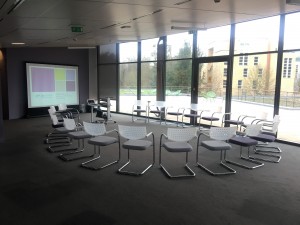Mindfulness
Boosting well-being in business
.
Article by Thomas Emmanuel Gérard for the Octave webmagazine
Thomas Emmanuel Gérard provides change management consulting for businesses. His in-depth approach focuses on people as individuals and as a group (mindfulness, collective intelligence, coaching). He is the founder of Mindful Intelligence and co-created the Mindful at Work program, a course on mindfulness at work that he has implemented in many companies through more than 300 hours of training. www.mindfulintelligence.com
In recent years, mindfulness, or mindful meditation, has made its appearance in the business world. In an uncertain economy, meditation helps to bring harmony to the workplace and serenity to businesses.
But what is mindfulness?
Mindfulness is the art of being available to yourself in the here and now, the art of observing the sensations in your body, your sensory perceptions, thoughts and emotions, being both fully aware of what is around you, while being able to take a step back, to contemplate something without judging it.
It is based on breathing exercises and periods of meditation, which help to connect yourself with the present. For example, you breathe in and you concentrate on your breath; you breathe out and you are aware of your exhalation. You walk and you can feel the pressure of your feet against the floor, you are aware of your muscles. You eat a piece of fruit and you are aware of its texture, its taste and its smell. You are not on autopilot, you experience every second to the full. You can observe your emerging emotions: for example, you can feel your rising anger, you’re sad, you’re afraid, you’re happy… and you’re aware that the emotion is there. The practice of mindfulness invites you to acknowledge what is happening peacefully, and without judging.
What benefits can it have for employees?
Employees can be hugely affected by the uncertain economic climate that impacts our businesses. In high-pressure situations – a heated discussion with a colleague, a critical team meeting, a provocative email – breathing and meditation exercises will help acknowledge these emotions: identify them, name them, take care of them, and as a result, keep them from triggering an immediate reaction. They help to put a different perspective on the situation, distancing emotions from how a situation is interpreted or projected. But it certainly does not mean ‘doing nothing’. Sometimes setting limits, or sharing feelings, are legitimate responses. But training in mindfulness provides the opportunity to let go, to give a response – and not a reaction – to a tense situation. For example: give a moderate response, stop chewing over your worries, consider stress generators from a different angle, find the peaceful inner calm at the heart of the storm. Mindfulness is a way to rediscover yourself in order to approach others better. It’s about finding an anchor and an alignment that will allow you to engage with others in confidence and security, even in a difficult environment.
How are companies taking an interest in mindfulness?
Today, mindfulness has gone well beyond the scope of meditation and personal development. So the companies who use it are true pioneers. In France, these include Sodexo, MAIF, Airbus, L’Oréal and several others, but most say very little about the subject.
The vast majority of companies are still reluctant to give their employees the opportunity to meditate, even though their employees seem willing to experiment, as long as it is voluntary. I think this reflects a major change in the relationships to work that employees are calling for: creating conditions that are conducive to well-being in the company is more beneficial to employees than offering stress management techniques. Prevention is better than cure.
In terms of employee welfare, Sodexo and MAIF really are pioneers. I have facilitated 10 long programs on introducing mindfulness (7×3 hrs) in those two companies. The meditation I recommend is focused on issues encountered in the workplace: relaxing under stressful conditions, combining performance and serenity, finding a creative and comforting response to a difficult situation, listening to yourself to make fair decisions, and daring to contribute to a harmonious atmosphere within the team, anchoring your performance in trust.
Other companies have decided to integrate mindfulness workshops in their Talents programs. These training and discussion programs for managers who shoulder responsibility within the group are comfortable experimenting with these alternative workshops because the experiment takes place in a ‘safe place’, where the development of social skills is encouraged.
Can mindfulness training be abused by companies to increase their employees’ ability to cope with pressure?
Mindfulness is not immune to exploitation, but I have never witnessed that in the programs that I have undertaken; all of them focused on employee well-being. In any case, I’m not sure that the reason why the training is offered is the real question here. I think that the professional and personal benefits experienced by the program’s participants and also by extension, the benefits for those in their immediate professional circle, should be the focus of attention. It is now accepted that the performance of a company is closely linked to its employees’ welfare. With the introduction of mindfulness in business, the entire working population stands to benefit. And of course, ultimately, the company itself.
Meditation and neuroscience
The benefits of meditation have now been proven scientifically. Since the late 1970s, a considerable part of the scientific community has confirmed the positive effects of meditation on the body (decrease in blood pressure, strengthening of the immune system, lower perception of physical pain, etc.) and mind (emotional balance, tempering of fear, empathy, compassion, etc.).
Through the recent emergence of neuroscience over the last 15 years, we have been able to gain a better understanding of what happens inside the brain when we meditate. For example, breathing slowly and focusing our attention on sensations in the body help to activate the parasympathetic nervous system: the brain then releases neurotransmitters (DHEA, serotonin, and endorphin) that will lower the heart rate and blood pressure. By strengthening the prefrontal cortex, meditation also improves cognitive skills: the ability to assess a situation, focus attention, etc. With the use of MRI, scientists have discovered that the brains of experienced meditators produce gamma waves, which result from the synchronization of multiple brain regions involved in regulating attention and emotions. The good news is that even beginners can benefit from meditation: by activating their prefrontal cortex, they increase their ability to concentrate and strengthen empathy networks. When dealing with strong emotions, people who meditate will be able to identify and put a name to their thoughts and emotions. In the brain, it has the effect of applying brakes to the limbic system. This is a neural system that when activated, conveys emotions and impedes our cognitive abilities: memory, language, logical thought or concentration. So the practice of mindfulness acts as a moderator, or regulator, of emotions.
Share this Post











